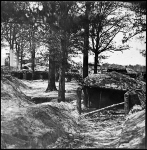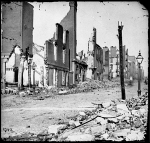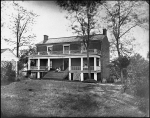
Copyright © Randy Strickland, 1998, 1999, 2000, 2001, 2002, 2003, 2004, 2005, 2006, 2007, 2008, 2009, 2010, 2011
|
|
||||||||||
|
||||||||||

|
As the war continued, the Government of the Confederacy started the inevitable, suing for peace. The last week of January 1865, Peace Commissioners from both sides began meetings in Hampton Roads. These efforts turned out to be futile. Meanwhile, back in Petersburg, the seige continued. General Lee, acting on a suggestion from his trusted friend and advisor, General James Longstreet, sent a message to General Grant requesting what could be done to end this terrible war.
|
|
Even though General Lee did not know that General Grant had already been informed that he did not have the authority to settle the terms of peace and was ordered to press the military solution to its extreme, he began to make plans for his next move. A move that could very well prove to be the last move of a desperate army.
|

|
Even before General Grant sent his answer, General Lee called General John B. Gordon to his headquarters at Edge Hill. Throughout the next few days,in early March of 1864, General Gordon formulated plans for an assault on the northern end of the Union fortifications. The initial assault was to be on Union Fort Steadman, but it was hoped that the campaign would continue on to other Union fortifications, sweeping them up from the rear.
|
|
The assault on Fort Steadman was planned for early the morning of 25 March 1865, a surprise attack... designed to catch the Union troops off guard. It was hoped that thousands of Confederate infantry could pour through the breach before the Union could bring up reinforcements.
| 
|
|
The attack was successful, at first. The Confederates not only took Fort Steadman, but were succesful in taking the two fortifications to either side. However, as morning light came, the Union army was able to bring reserves in to line that overwhelmed the smaller Confederate force. By eight o'clock AM, it was all over. All that had been gained was lost. The Confederates had lost over 5,000 men in what would be their last major offensive action. General Grant's forces were beginning to be shifted to the west end of the Petersburgh defensive positions. On 31 March 1865, General Sheridan's cavalry began an assault on General Pickett's position at Five Forks. Five Forks, a cross roads west of the Petersburg defenses, contolled General Lee's last rail connection...the Southside Railroad. On 01 April 1865, General Sheridan, supported by infantry from the Union V Corps, smashed through General Pickett's flank and rolled up his lines. On 02 April 1865, having received word of the Union victory at Five Forks, General Grant ordered a general assault on the Petersburg defenses. The Union VI Corps broke through and collapsed the entire Confederate right flank. A brave and determined fight was put up by the Confederate defenders at Fort Gregg. Only through sheer detemination, did the Confederate defenders stem the on rush of Union troops. It was during this breach that General Lee lost yet another great friend and Lieutenent...General A.P. Hill was killed in action, while rallying his troops to fight the Union invaders.
|
|
President Jefferson Davis was in church when word reached him that General Lee could "hold his position no longer." He immediately started to remove as much of his government from Richmond, as was possible. As the Confederate Government evacuated, the mills and factories of Richmond were ordered destroyed. A Confederate soldier described the scene, "an ocean of flame is dashing, as a tidal wave of destruction...from street to street...miles and miles of fire, mountain on mountain of smoke."
| 
|
|
Meanwhile, General Lee had placed his army on the move from his now captured works of Petersburg, to Amelia Courthouse, on the Richmond and Danville Railroad. He was hoping to regroup his forces here and using the railroad, join forces with General Joe Johnston. General Grant, guessing General Lee's intentions, sent General Sheridan and his cavalry south of General Lee's position and cut off his retreat. General Lee had to change his plans and started his army towards Lynchburg, Virginia...some sixty miles away. Once again the two opposing armies were in a race to out maneuver one another. General Grant and his Generals kept the pressure up on the mortally wounded Confederate army. Numerous harrassing battles took place during the next several days. At Sayler's Creek, General Sheridan troopers captured a Confederate wagon train and calling on the VI Corps, attacked the Confederate rear guard. Over 6,000 Confederate soldiers were captured, including General Dick Ewell and General Lee's son, Custis Lee. General Lee spent that night in Farmville, Virginia. He was hoping to feed what was left of his brave legions, from a supply train that was waiting at Farmville. Before this was accomplished, word was received that Union troops were crossing the Appomatox River at High Bridege. It was necessary to send the trains on to Appomatox Station and evacuate Farmville. The Union troops were so quick to arrive, they were able to harry the rear of the retreating Confederate army. On 08 April 1865, General George Custer's cavalry captured the supply train near Appomatox Station, just west of General lee and his retreating army. The next day, 09 April 1865, General Lee's troops beat back General Sheridan's cavalry blocking the road to Lynchburg...only to be faced by lines of Union infantry. As the opposing armies prepared for the final massive assault, General Lee sent a rider, under a flag of truce, with a message for General Grant. There were several notes sent back and forth between the two commanding Generals, Lee and Grant. General Lee was trying to probe General Grant for his terms, as he was unable to allow his soldiers to be mistreated. General Grant assured him his terms would be generous and they agreed to meet at Appomatox Courthouse.
|
|
It was well after one o'clock PM when General Grant finally arrived at the meeting place. His uniform and boots were covered with mud splatters from his ride. He entered the parlor of the McClean House and greeted General Lee. Behind him, entered at least a dozen Union officers to witness the historic meeting. After some conversation in which the two Commanding Generals made small talk about old times, General Lee prompted General Grant to state what his conditions and terms for surrender would be. General grant stated he wished that the Confederate soldiers "merely...lay down their arms, not to take them up again during the continuance of the war unless duly and properly exchanged." General Lee than suggested these terms be written down. When General lee read the terms, he was both surprised and pleased to learn that his officers would be allowed to keep their side arms, private horses, and baggage. Having done this, General Lee pointed out that many of the horse being used by his cavalry and artillery units were likewise, privately owned. General Grant, not wanting to change the written terms, stated he would instruct the officers administering the parole to allow anyone claiming ownership of horse or mule, to retain that ownership. General Lee than wrote a letter accepting the terms offered by General Grant. Upon having these documents copied and signed, General Lee prepared to leave. Before leaving the proceedings, General Lee remarked that his soldiers were in need of food and other supplies. General Grant told him he would authorize him to send his commissary and quartermester to Appomattox Station, where they could obtain rations from the Confederate trains that were captured there. As General Lee left the McClean House, mounted his now famous horse Traveler, he knew he must ride back through his gallant soldiers. The look of defeat marked his features and all that saw him knew that the end had come. Southern independence was not to be, they were to return to their homes, their loved ones and begin to rebuild. General Lee aske Colonel Marshall to daft a farewell message to his army. Once it was completed, a few changes made...he signed it, ordered copies to be made and distributed to his Corps Commanders. It was merely General Order # 9, no reading to the massed soldiers. no posturing before the people, as was his custom...General Lee said good-bye with great dignity.
|
|
The war had lasted for four terrible years. Hundreds of thousands of lives had been lost, hundreds of thousands more had been devastated or changed forever. No one was untouched by its far reaching affect. Billions of dollars had been spent or lost. It had destroyed the Southern way of life forever, and had changed the Northern way of life almost as much. To this very day, there are disagreements as to how it started or why. It is just as much a mystery as to how it truly ended. The battlefield was but one place the war was decided. There are many others; government betrayal, greed, lack of support...on either side. As in all American wars, the people will never know the whole truth.
|



